Guitar strings, although not a part of the actual guitar, is a key part of the instrument’s music-making system.
If your guitar is going to produce beautiful music, you’d better get schooled up on the ins and outs of guitar strings.
That’s precisely what this guide will provide you with.
Contents
Guitar String Basics
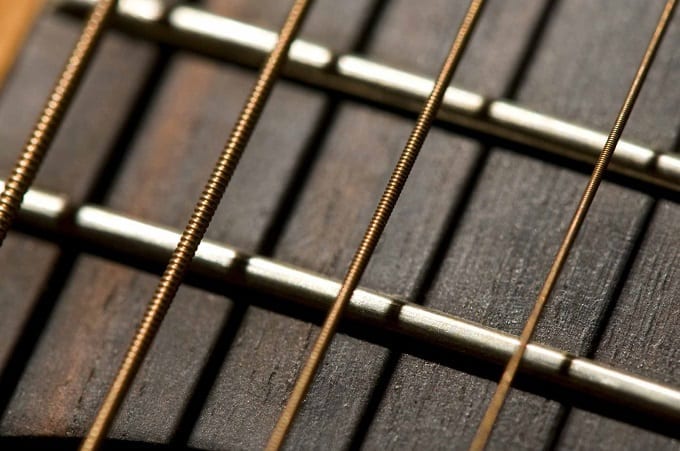
There are six strings on a guitar.
If you have an electric or acoustic guitar, the strings will be made of metal. All other guitar strings will be made of nylon.
The strings are numbered from one through to six.
The first string is the thinnest one and is located closest to the floor when you are holding the guitar in the playing position.
The string numbers relate to the letter names of the open strings, from A through E, with E relating to the 6th string and the first string.
The order of the strings is as follows:
E, A, D, G, B, E.
Here’s a memory aid to help you to remember this order . . .
Eddie Ate Dynamite, Goodbye Eddie.
There are two types of strings referred to:
- Open strings
- Fretted strings
Open strings are those that can be played while pressing down with a left-hand finger.
Fretted strings are played when you press it down on a fret (the thin metal bar running across the fretboard).
How to Choose the Right Guitar Strings for your Guitar
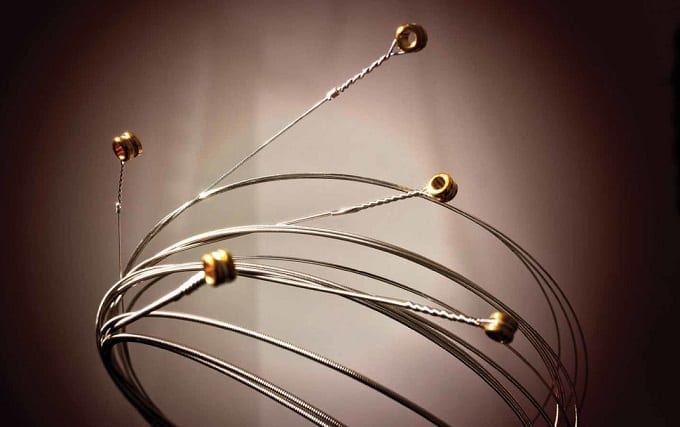
After identifying the type of guitar you have (acoustic, classical, electric), you need to take into account the sort of tone you want your guitar to produce.
It is imperative that you buy the correct string type for your guitar. If you don’t you can damage your precious instrument.
This is especially the case if you put steel strings on a classical guitar!
And if you were to put nylon strings on an acoustic guitar they would not be able to produce the required level of vibration.
Strings are rated according to their gauge. Generally, the lighter the gauge, the more suitable it is for delicate playing such as fingerpicking.
A heavier gauge would be better suited to a strumming style of play.
Heavier string gauges will produce a broad, thick tone, whereas lighter strings will do the opposite.
Light gauge strings are generally easier to play and are recommended for beginners.
Electric guitars usually have nickel bound strings whereas steel strings are best for acoustic guitars. Classical guitars are best suited toward nylon strings.
What do Guitar Gauges Mean?
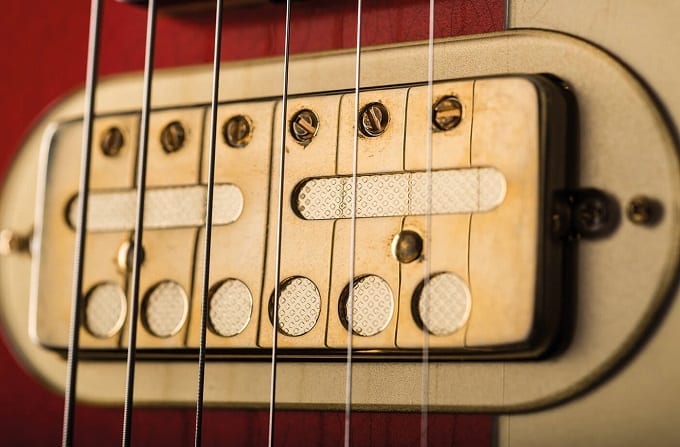
The main differentiating feature of a guitar string is its thickness.
The technical term for the thickness of a string is its gauge. The difference between gauges to make a substantial difference in performance can be very minute.
The difference can be up to thousandths of an inch. This imperceptible difference is enough to make a big difference in the tone and sound that your guitar produces.
The gauge of the string also makes a difference as to how much work your fingers have to do. The lighter the string gauge, the easier it is to play the guitar.
However, because they are thinner, they are more likely to break. This makes them a double-edged sword for new guitar players.
One the one hand, they will be easier to play and less work on your fingers.
But, on the other hand, they are easier to break, so that a fumbling beginner is more likely to have that problem.
Thin gauge strings are easier to play at a faster tempo. They also put less stress on the neck of the guitar. You’ll get a lower volume from then and they are harder to tune.
Heavy gauge strings will give you a greater level of sound and volume. They are also, however, harder to play.
You will put a lot more stress on your fingers the higher the string gauge that you are playing with. They also put more stress on the neck of your guitar.
How to Measure Guitar String Gauges?
Strings gauges are classified according to categories of lightness or heaviness as follows;
- Extra light: .010, .014, .023, .030, .039, .047
- Custom light: .011, .015, .023, .032, .042, .052
- Light: .012, .016, .025, .032, .042, .054
- Medium: .013, .017, .035, .045, .056
- Heavy: .014, .018, .027, .047, .059
How to Choose the Right Guitar Strings for Your Guitar?
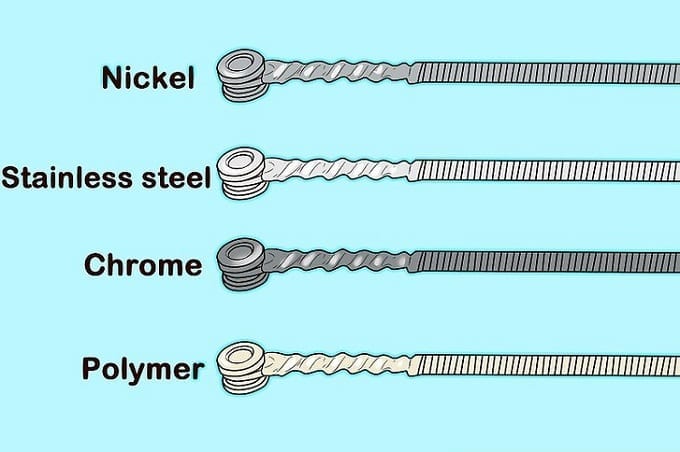
Nylon Strings
Nylon strings will give you a softer, more mellow tone than steel or nickel bound strings.
They are also nowhere near as hard on your fingers as the other options.
Pick-ball nylon strings are heavier than conventional nylon. They are ideal for heavier strumming styles, such as when playing folk guitar style.
You can also purchase bronze strings which are a lighter gauge than the conventional nylon string. They will produce a sharp, crisp sound.
Finger Style Strings
The best strings for fingerstyle playing are those made of silk and steel.
You’ll find that these types of strings are less tiresome on your fingers than conventional metal strings.
Flat polished strings are also a good choice for beginners.
Monel Strings
Monel strings are designed for advanced guitar players. They are made of metal and require hardy fingers.
The sound produced on Monel strings is sharper and louder than on other strings. They are available in a range of gauges.
However, you should not use Monel strings on an electric or classical guitar.
Electric Guitar Strings
Flat wound strings are the best choice for your electric guitar. These strings are easy on your fingers and produce a very pleasing amplified tone.
Acoustic Guitar Focus

Generally speaking, the thicker the string you select for your acoustic guitar, the better your acoustic instrument will perform.
You will get a broader sound, the thicker the string is, while a thin string will give a less powerful sound.
Thinner strings are the best choice, however, for new guitar players.
Playing guitar is very tiring on untrained fingers, which is why you should always begin with the thinnest string that will do the job for you.
Keep in mind that acoustic guitars do not give you the benefit of any amplification. As a result, the strings have to work harder to produce a comparable level.
That’s why acoustic guitar strings tend to be bigger than those that are designed for an electric guitar.
When purchasing strings for your acoustic guitar you have the following options:
- Steel
- Nylon
- Bronze
- Phosphor Bronze
- Brass
- Aluminum Bronze
- Silk & Steel
- Polymer coated
Let’s drill down on the most popular acoustic guitar strings
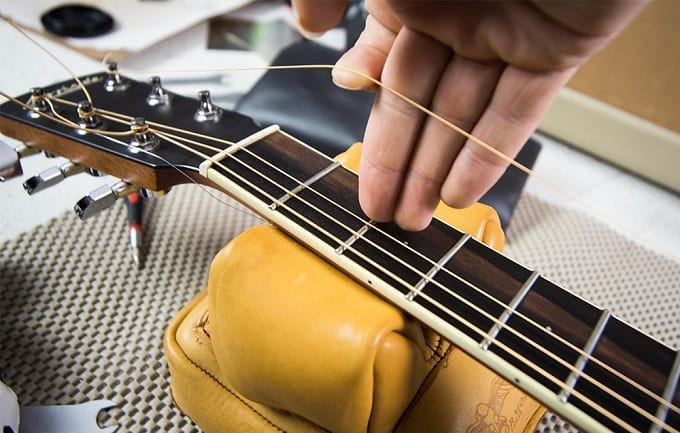
Steel
Very often steel strings designed for acoustic guitars are impregnated with a mixture of bronze and nickel.
This will help to achieve a clearer sound. Steel strings that are made for acoustics will deliver a heavier sound than steel strings that are intended for electric guitars.
Nylon
Nylon strings are the most common type of string used for classical guitars. But you can also use them on an acoustic guitar.
Do not, however, use a nylon-string on an electric guitar. Nylon will not allow for the magnetic field to flow. As a result, it will not even produce any sound!
Bronze
Bronze strings are popular due to their ability to produce a very clear, bell-like tone.
However, of all the string types, bronze strings are the most likely to wear and need replacing. That’s because they can rust very quickly.
A variant of bronze strings is those that have been infused with phosphorus. These strings will produce a crisper sound than conventional bronze strings.
The addition of phosphorus will also offset the oxidizing problem.
You can also purchase aluminum bronze guitar strings. They will give you a higher tone and a better bass and treble balance than other versions of bronze strings.
Brass
Brass strings will give your guitar a metallic sound.
Silk & Steel
The blending of silk and steel in a guitar string are made with a steel core that is then enveloped with silk on the lower strings.
The tone that this type of string makes it among the most delicate of any string type.
Polymer
Guitar strings that are coated with polymer produce a slighter warmer sound.
However, the main reason for the polymer coating is to protect the strings from rusting.
Electric Guitar Focus
When it comes to your electric guitar, you have two string options:
- Round wound strings
- Flat wound strings
Round Wound Strings
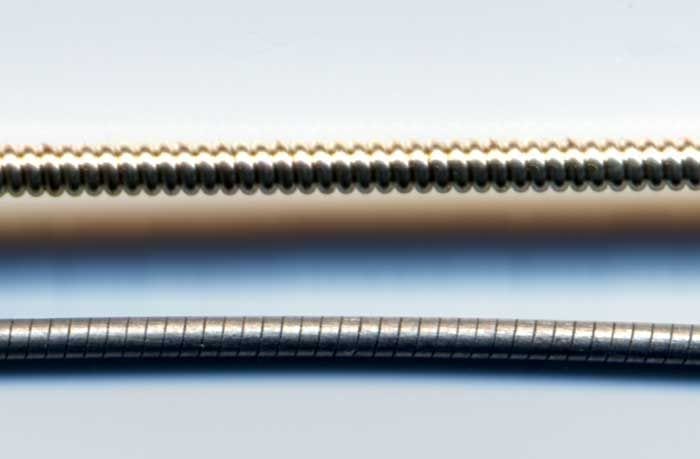
These strings have a metal core which is encased in the wire that is usually made of nickel-plated, or even pure nickel, steel – but only on the three (or at times four) thickest of the strings.
There is no wrapping on the three (or at times two) thinner strings. As a result, we call these the plain strings in a round wound string set.
Round wound strings will produce a bright tone. Those that are wound in pure nickel will give a warmer sound.
Flat Wound Strings
These strings are made by wrapping the metal core with steel wire. The soft, warm, smooth sound that they produce is ideally suited to jazz music.
Changing Your Guitar Strings
Changing your guitar strings is not something that you need to be fearful of.
Doing so will give your guitar a better sound, overcome the danger of broken strings and can also make you aware of other, hidden problems such as a rattling tuning post.
Every time you play your guitar, the strings will slowly deteriorate. If they are never changed, they will eventually break.
If a string does break you will obviously have to replace it immediately. In terms of general string maintenance, however, you should replace all of the strings at the same time.
So, when should you replace your strings? You should do so if you notice the following:
- They are corroded
- They will not play in tune
To remove a string, you simply turn the tuning peg so that the string is loosened to the extent that you can take a hold of it in its center and pull it from its post.
You can also use a wire cutter to simply cut the string off. Of course, you may want to keep the old string to have it as a spare, in which case you would not cut it off.
There is no advantage in replacing the strings one at a time. You will probably find it more convenient to take all of the strings off at the same time.
Restringing your guitar will differ according to the type of guitar you are working with. Let’s consider the options.
Stringing an Acoustic Guitar
Acoustic guitar strings are attached to the bridge and the headstock.
Bridge Attachment
1. Remove the old strings and take out the bridge pin.
2. Locate the end of the new string that has a small brass ring on it and put it inside the bridge pinhole.
3. Now put the wedge back into the hole so that the slot is facing forward. You’ll see that this slot has a channel to allow the string to exit the hole.
4. Gently pull on the string until the small brass ring rests on the bottom of the pin. Keep a finger on the pin as you do this.
5. Gently pull on the string to test it – it shouldn’t shift.
You can now secure the other end of the string to the tuning post. The procedure is slightly different for the treble strings and the bass strings.
Treble strings (G, B, E)
- Put the string through the post hole, leaving enough slack to wrap around the post a few times when tuning.
- Use a finger to cause a kink in the string facing the inside of the instrument.
- Maintain tightness against the post with one hand, while turning the tuning peg clockwise with the other hand.
Bass Strings (A, C, D)
- Put the string through the post hole, leaving enough slack to wrap around the post a few times when tuning.
- Use a finger to cause a kink in the string facing the inside of the instrument.
- Maintain tightness against the post with one hand, while turning the tuning peg counter-clockwise with the other hand.
Tuning Up
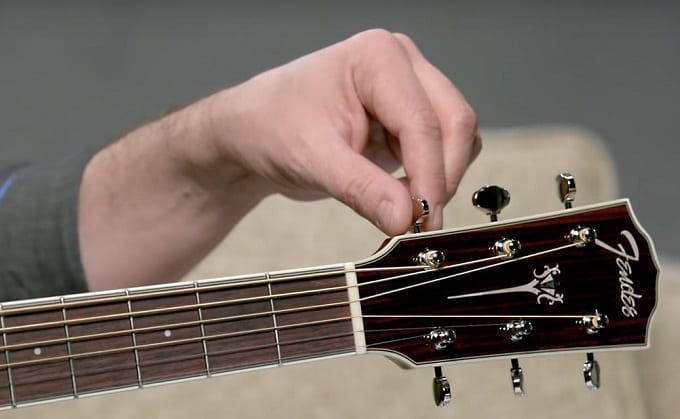
After you’ve attached the strings and begun to wind it with the tuning key, the strings will begin to come into the pitch.
To fine-tune the strings, refer to our 12 Tips for Guitar Tuning.
Once you have tuned the string you should give it a light pull in various places to make sure that it is properly stretched out.
This may cause it to go flat, so you might have to retune after you’ve done this.
Stringing a Nylon Guitar
You should find nylon strings easier to handle than steel ones because they don’t have the springiness factor.
- Remove the old strings
- Put one of the strings through the hole at the top of the bridge with about an inch and a half sticking out of the hole
- Make the strings secure bypassing the short end over the bridge and under the rest of the string. Then pass it under, over and then under itself on the top of the bridge
- Pull the string and secure the knot in order to remove any slack
- Now pass the string through the hole in the tuning post at the other end of the guitar
- Form a U shaped loop bypassing the string over the roller and then under itself in front of the hole
- Wrap the short end around the roller 2-3 times
- Wind the peg to get the string to wrap on top of the loop
- Maintain tightness against the post with one hand, while turning the tuning peg clockwise with the other hand
Stringing an Electric Guitar
It is easier to change the strings on an electric guitar than any other. This is because they will need to be replaced more often.
- Attach the string to the bridge by passing it through the bridge hole. The ball at the end of the string will hold it against the bridge.
- Pass the string through the post hole at the other end of the guitar. Then kink the string inward.
- Maintain tightness against the post with one hand, while turning the tuning peg clockwise with the other hand.
Conclusion
Now that you’ve got a good grounding on the ins and outs of guitar strings you’re in a great position to maximize the sound potential of your guitar.
Follow our guidance to select, tune and replace your strings and you’ll be making sweet music for many years to come.


